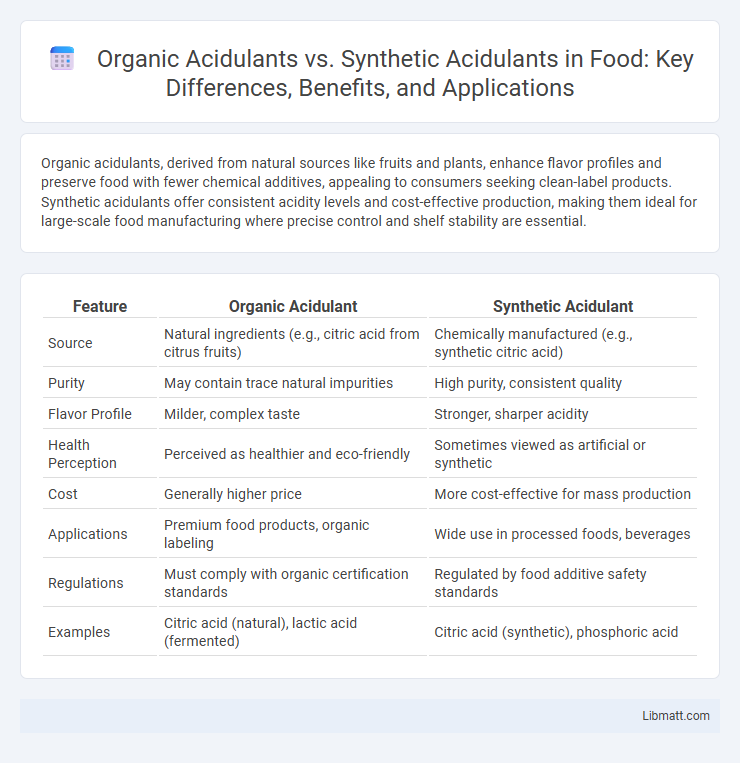Organic acidulants, derived from natural sources like fruits and plants, enhance flavor profiles and preserve food with fewer chemical additives, appealing to consumers seeking clean-label products. Synthetic acidulants offer consistent acidity levels and cost-effective production, making them ideal for large-scale food manufacturing where precise control and shelf stability are essential.
Table of Comparison
| Feature | Organic Acidulant | Synthetic Acidulant |
|---|---|---|
| Source | Natural ingredients (e.g., citric acid from citrus fruits) | Chemically manufactured (e.g., synthetic citric acid) |
| Purity | May contain trace natural impurities | High purity, consistent quality |
| Flavor Profile | Milder, complex taste | Stronger, sharper acidity |
| Health Perception | Perceived as healthier and eco-friendly | Sometimes viewed as artificial or synthetic |
| Cost | Generally higher price | More cost-effective for mass production |
| Applications | Premium food products, organic labeling | Wide use in processed foods, beverages |
| Regulations | Must comply with organic certification standards | Regulated by food additive safety standards |
| Examples | Citric acid (natural), lactic acid (fermented) | Citric acid (synthetic), phosphoric acid |
Introduction to Acidulants
Acidulants are substances that modify the acidity or pH of food products, enhancing flavor, preservation, and texture. Organic acidulants, such as citric acid and lactic acid, are naturally derived from fruits, fermentation processes, or other biological sources. Synthetic acidulants like phosphoric acid and malic acid are chemically manufactured, offering consistent purity and acidity control for food and beverage applications.
Defining Organic Acidulants
Organic acidulants are naturally derived compounds primarily found in fruits, vegetables, and fermented products, known for their ability to enhance flavor and preserve food by lowering pH levels. Common examples include citric acid from citrus fruits, malic acid from apples, and lactic acid produced through fermentation processes. These acidulants contribute not only to taste and preservation but also offer potential health benefits due to their natural origin and bioavailability.
Understanding Synthetic Acidulants
Synthetic acidulants, commonly used in the food industry, include compounds like citric acid, phosphoric acid, and malic acid, which are chemically manufactured for consistent purity and strength. These acidulants enhance flavor, preserve products, and regulate pH with precision, often offering cost-effective and scalable solutions compared to organic alternatives. Their synthetic origin allows for controlled composition, reducing variability and ensuring stability in processed foods and beverages.
Key Differences Between Organic and Synthetic Acidulants
Organic acidulants, derived from natural sources like fruits and fermented products, provide a milder acidity and often contain beneficial nutrients or antioxidants. Synthetic acidulants are chemically manufactured, delivering a more intense and consistent acidic profile with precise pH control in food products. Your choice between organic and synthetic acidulants can impact flavor profiles, nutritional value, and regulatory compliance in food formulation.
Common Examples of Organic Acidulants
Common examples of organic acidulants include citric acid, malic acid, and lactic acid, which are naturally derived from fruits, vegetables, and fermentation processes. These organic acidulants enhance flavor and act as preservatives in foods and beverages without the synthetic additives found in artificial acidulants. Using organic acidulants can support your preference for natural ingredients and cleaner labels in product formulations.
Popular Synthetic Acidulants in Industry
Popular synthetic acidulants in the food industry include citric acid, phosphoric acid, and lactic acid, widely used for their cost-effectiveness and consistent quality. These synthetic acidulants provide precise pH control, enhance flavor profiles, and improve product shelf life in beverages, canned goods, and confectionery. Your choice between organic and synthetic acidulants depends on formulation goals, regulatory preferences, and consumer market trends.
Health Impacts: Organic vs Synthetic Acidulants
Organic acidulants, derived from natural sources such as fruits and fermentation processes, typically contain fewer synthetic additives and are often perceived as safer for digestive health due to their natural composition and presence of beneficial bioactive compounds. Synthetic acidulants, commonly produced through industrial chemical processes, may contribute to gastrointestinal irritation or allergic reactions in sensitive individuals due to their artificial origin and potential for higher acidity levels. Studies suggest that organic acidulants support better metabolic balance and reduce exposure to potentially harmful synthetic residues, promoting overall health and well-being.
Environmental Considerations
Organic acidulants, derived from natural sources such as fruits and fermentation processes, typically have a lower environmental impact due to biodegradable properties and sustainable sourcing methods. Synthetic acidulants, often produced through chemical synthesis involving fossil fuels, can contribute to higher carbon emissions and resource depletion. Choosing organic acidulants supports eco-friendly practices that align with your commitment to reducing environmental footprints.
Application in Food and Beverage Processing
Organic acidulants, such as citric acid from citrus fruits and lactic acid from fermentation, are preferred in natural and clean-label food and beverage products for their mild flavor profiles and perceived health benefits. Synthetic acidulants like phosphoric acid and malic acid are widely used for precise pH control, extended shelf-life, and cost efficiency in carbonated drinks, processed foods, and confectionery. Food and beverage processors select acidulants based on product formulation requirements, regulatory standards, and consumer demand for natural ingredients.
Choosing the Right Acidulant for Your Needs
Choosing the right acidulant is essential for tailoring flavor, preserving quality, and meeting dietary preferences in food and beverages. Organic acidulants like citric acid or lactic acid offer natural sourcing and are often favored in clean-label products, while synthetic acidulants such as phosphoric acid provide stronger acidity and cost-effective preservation. Understanding the balance between organic and synthetic options allows you to optimize taste profiles and ingredient transparency for your specific manufacturing or culinary needs.
Organic Acidulant vs Synthetic Acidulant Infographic

 libmatt.com
libmatt.com